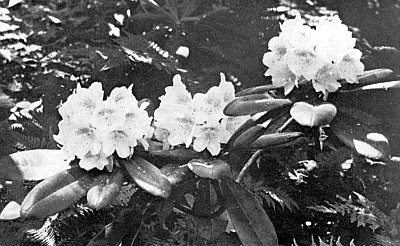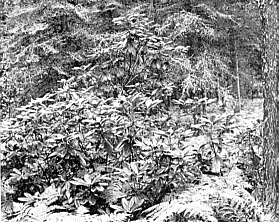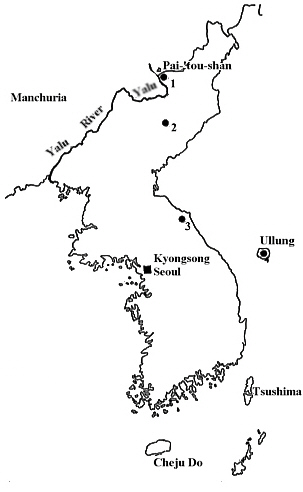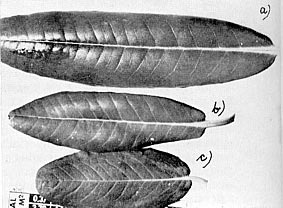QBARS - v26n3 R. brachycarpum ssp. tigerstedtii, A New Subspecies
Rhododendron brachycarpum D. Don Ex G. Don Ssp. tigerstedtii,
A New Subspecies (Preliminary Report)
Dr. Tor G. Nitzelius, Goteborg
1
1
From the original article printed in the Deutsche Baumshule, July 1970.
Translated through the courtesy of Dr, E. E. Leppik, New Crops Research Branch, Beltsville, Md.
|
|
As a result of a survey of the Japanese large leaved Rhododendron species (Nitzelius 1962 and 1963), the name R. brachycarpum D. Don ex G. Don was proposed for the species occurring in Japan and Korea and cultivated in Western Gardens since the mid 1800's. The names, R. fauriei Franchet and R. F. var. rufescens Nakai should be considered as synonyms. This proposal has already been accepted by several authors, including Ohwi (1965). It was also proposed to accept the specimen of R. brachycarpum from the Gray herbarium, collected at Fuji-Yama by C. J. Maximowicz, as the neotype of this species. The original specimen (probably collected by Siebold between 1823 and 1830) is obviously lost. Maximowicz's well preserved specimen in the Gray herbarium (Nitzelius 1962 p. 147) was presumably collected from the same area as Don's plant, and agrees with Don's short but good description. This proposal was also accepted by the Gray herbarium.
During the further study of herbarium material and living plants in their native area, I became convinced of the great morphological and physiologic variability of this species within its area of natural distribution. A critical revision of original material would possibly yield several geographic subspecies and varieties.
In the meantime I became more and more convinced that the Korean R. brachycarpum is a distinctive subspecies. The extraordinary winter hardiness and floral beauty make this shrub an important ornamental for the northern countries. A preliminary description follows below.
The name ssp. tigerstedtii was chosen to honor Dr. Tigerstedt, the former owner of the world-known Mustila Arboretum in south Finland. He introduced this Rhododendron species from Kongo-San-Gebirge (Kang-wan-do: Keum gang san) in east-central Korea. Dr. Tigerstedt visited me in the year 1955 and brought us an herbarium specimen of the Korean R. brachycarpum from his own planting in Mustila. For comparison he also brought an example of the Japanese R. brachycarpum from a nursery.
Because of the larger size of leaves and flowers of the Korean plants, I became convinced that it should be considered a new subspecies.

|
|
FIG. 62.
R. brachycarpum ssp. tigerstedtii
in the botanical
garden, Goteborg. The specimens are now 2-3 m high and were grown from seeds originating from Mustila, Finland. |
In the Botanical Garden of Goteborg there are plants obtained from Mustila that are now the height of a man and which have been flowering several years. The Korean plants have certain morphological characters distinct from the Japanese R. brachycarpum , in particular the longer shoots, larger leaves, and flowers. In addition to this, the Korean R. b. ssp . tigerstedtii is winter hardy and has withstood -45° C (-49° F) in Mustila without any damage to the plants. At Goteborg, R. b. ssp. tigerstedtii normally flowers two to three weeks earlier than the Japanese form of R. brachycarpum , although the flowering times of both forms overlap and the frequent hybridization makes the differentiation of both forms difficult.
DESCRIPTION RHODODENDRON BRACHYCARPUM D.
Don ex G. Don in Gen. Syst. Vol. 3: 843 (1834).
Subspecies TIGERSTEDTH Nitz. ssp. nov.
Based on R. brachycarpum ssp. brachycarpum (neotype from Maximowicz's collection of 1862 from Fuji.) Description of the subspecies: frutice, altiore, ramulis hornotinis robustioribus, foliis 15-25 cm latis; floribus albis ca. 7 cm diametrientibus; pedicellis 3-5 cm longis; calyce majore subapplanato, altius divisio.
Holotype in the Herbarium of the Botanical Gardens, Goteborg. Specimens studied : Korea, Yangangdo, "In the fir forest of the mountain pass Abu Uza Kogar (Abu San?). in Yalu - Bassain, group of four shrubs", June 21, 1897, Komarov (LE) ! - Pungsan 1956, Pong Syup Joh. s. n. R. fauriei v. rufescens (TNS)! - Kangwondo, Keum Gang San (Mt. Kongo), Miroku-ho, 1.600 m, July 6, 1918, Wilson No. 10466 (GH, K) ! - "Mt. Kongo", July 29, 1938, S. Bokusawa, s. n. R. fauriei v. rufescens (TNS)! - "Mt. Kongo", Aug. 7, 1940, S. Okuyama, s. n. R. fauriei v. rufescens (TNS)! - Kyongsan-Pukto, Ullung-do (Dagelet Island), "on cliffs in woods, common, 200-900m", June 13, 1917, Wilson No. 8512 (GH, K)! - Ullung-do, July 1, 1948, Chung In Cho (TNS)!
R. brachycarpum D. Don ex G. Don has been assigned by Stevenson (1930) to the series Ponticum subseries Caucasium , by Sleumer (1949) to the subsection Pontica and by seithe-v. Hoff (1960) to the subsection Hymenanthes . But undoubtedly this species belongs to the sub-section Lactea Sleumer. This statement is supported by the fact that the thin rust brown covering is composed of radiate hairs, as in the subsection Lactea (Cowan 1950, p. 57; Seithe-v. Hoff 1960, p. 367). Cowan and Davidian (1956, p. 123, 124) remark that R. brachycarpum is "comparable" in this respect with the subsection Lactea . They reject, however, assigning this species to the subs. Lactea because of its "candelabroid" inflorescence, according to my observations the inflorescence is not typical "candelabroid" as in the Ponticum series. In addition to this, there are other characteristics, such as the shape of buds, leaves, morphology of flowers, and other criteria which favor the placement of this species in to the subsection Lactea . This reassignment seems to be justified also, if the phytogeographic distribution of the plant is considered.
R. brachycarpum ssp. tigerstedtii is a tall shrub (5 m and taller) or small tree. Young shoots are 1 cm thick (Japanese ssp. about 0.7 cm) and scarcely covered with radiate hairs. The leaves are 15-25 cm long and 5-9 cm broad (Japanese from 7-15 cm long and 3-7 cm broad), covered below with radiate hairs. Flowering is normally 2-3 weeks earlier than in ssp. brachycarpum . Flowers white with greenish spots, 7 cm broad (Japanese ssp. about 5 cm.). Calyx flat, cup-shaped, with distinctive half incised lobes, about one month after anthesis. Pedicels of capsule 3-5 cm long (ssp. brachycarpum has a somewhat smaller cuneate calyx with indistinct lobes and with pedicels only 2-3 cm long). Seeds are much alike in both subspecies.

|
|
FIG. 64. 3 m high specimen of
R. brachy-
carpum ssp. tigerstedtii in the Arboretum at Mustila, Finland. Photo by Lipscombe , 1968 |
LITERATURE CITED
- Cowan, J. M. 1950. The Rhododendron leaf. A study of the epidermal appendages. Ed:nburg & London.
- Davidian, H. H., and Cowan, J. M. 1956. A review of Rhododendrons in their series. 6. The Lacteum series. - The Rhododendron and Camellia Yearbook, 1956: 122-155. R. Hort. Sec. London & Colchester.
- Maximowicz, C. J. 1870. Rhododendreae Asiae orientalis - Mem. Acad. Sci. St. Petersbourg. Set. 7. 16:1-53, Saint-Petersbourg.
- Nitzelius, T. G. 1962. Notes on some Japanese species of the genus Rhododendron. - Acta Hor.i Gotob. Vol. XXIV: 4. pp. 135-173. Goteborg.
- Nitzelius, T. G. 1963. Mitteilungen uber einige japanische Rhododendron; in Rhododendron and immergrune Laubgeholze, Jahrbuch 1963. Bremen.
- Ohwi, J. 1965. Flora of Japan. Engli. Ed. by F. G. Meyer and E. H. Walker, Smithsonian Institution, Washington, D.C.
- Seithe/v. Hoff, A. 1960. Die haaformen der gattung Rhododendron L. and die Moglichkeit ihrer taxonomischen Verwertung. - Bet. Jahrb. 79:297-393, pl. 7-11. Stuttgart.
- Sleumer, H. 1949. Ein system der gattung Rhododendron L. - Bot. Jahrb 74:511-533. Stuttgart.


